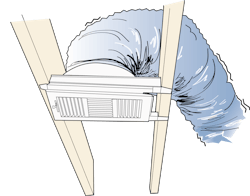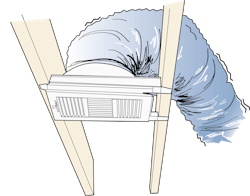The Consequences of Supply Registers in Attached Garages
If you pay attention to local or national news, you've probably seen reports about vehicles with remote start capabilities contributing to CO (carbon monoxide) poisonings.
In most stories, the car is accidentally turned on with the remote while parked in an attached garage.
The risk of CO poisoning increases in homes with supply registers that condition a garage attached to the living space. It's easy to assume that air will only blow out from these openings, but that could be a dangerous misconception.
Registers and the ducts connected to them may become unintentional pathways for auto exhaust and other harmful fumes to enter the living space. Let's look at how supply registers in an attached garage can have these deadly consequences if the wrong conditions occur.
Three Airflow Rules
It would help if you had some airflow basics to understand what happens when supply registers are in a garage. These three simple airflow rules will help you understand why this is an issue and how it can occur. They are:
1. Air always takes the path of least resistance
2. Air always goes from higher pressure to lower pressure
3. Heated air rises as cooler air falls – often called the stack effect.
Keep these principles in mind as we look at what happens when the HVAC blower is on and what can happen when it's off.
When the HVAC Blower is On
We typically focus on the HVAC blower operating in the "on" position with supply registers in a garage. The system delivers conditioned air into the garage during equipment operation to temper garage air. Many homeowners want to keep their water pipes from freezing or aUnfortunately, this practice may have unintended consequences. Let's say you have a three-ton system moving 1200 cfm (cubic feet per minute) of airflow. If you add 200 cfm of supply air to the garage with no return air, the house will have 1200 cfm of return air but only 1000 cfm of supply air.
An airflow imbalance now exists between supply and return airflow, creating negative pressure inside the home. The blower will try to pull the "missing" 200 cfm from wherever it can. This reaction can lead to back-drafting, excessive equipment run times, IAQ (indoor air quality) issues, and comfort problems. Remember, air takes the path of least resistance.
When the HVAC Blower is Off
Unless the HVAC blower is operating, supply register openings in the garage are simply pathways that connect the garage to the living space. They can pull air into the home just as easily as blow it out. Anytime there is an opening and a pressure difference across it, you will have airflow moving through that opening.
Automobile exhaust is the primary concern in this situation. CO produced by a car is always excessive and dangerous. Once the garage door is closed, it can hang around for a long time. If the customer backs in the vehicle, CO levels remaining in the garage are usually even higher.
When another fan inside the home is turned on to exhaust air outside -- such as a clothes dryer, bath fan, or kitchen exhaust fan -- an airflow imbalance is created. Air is pulled from the lowest resistance pathway to make up for air exhausted outside.
Unfortunately, a supply register opening could be a pathway for air to flow back into the home. Fumes can be pulled back into the living space if an automobile or fuel-burning equipment, like a gas grille or generator, runs in or near the garage.
Antennas Up
Be aware of the danger and keep your eyes open for any ducts that run into a garage or other attached building outside the main house. If you see this installation defect, you have a professional obligation to make your customers aware of potential dangers.
The best action is to eliminate any connections between the garage and the living area. If the customer wants to condition the garage, offer an upgrade to a ductless mini-split or separate heating and cooling system and make sure to isolate it from the living space.
Many codes prohibit the installation of supply registers in attached garages, but that doesn't mean you won't see it. It is usually an afterthought, added after the original installation.
The principles of airflow imbalance in a building apply to hundreds of field conditions. Be proactive and keep your antennas up for opportunities to offer your customers a higher level of safety.
David Richardson serves the HVAC industry as Director of Training for National Comfort Institute, Inc. (NCI). NCI specializes in training that focuses on improving, measuring, and verifying HVAC and Building Performance.
If you're an HVAC contractor or technician interested in learning more about adding carbon monoxide testing to your services, contact David at ncilink.com/ContactMe or call 800-633-7058. NCI's website www.nationalcomfortinstitute.com is full of free technical articles and downloads to help you improve your professionalism and strengthen your company.
Photo Captions
Photo 1: Air can flow backward through a supply register in the right conditions.
About the Author
David Richardson
Director, technical curriculum
David Richardson serves the HVAC industry as director of technical curriculum at National Comfort Institute, Inc. (NCI), Avon, Ohio. NCI specializes in training that focuses on improving, measuring, and verifying HVAC and Building Performance.

